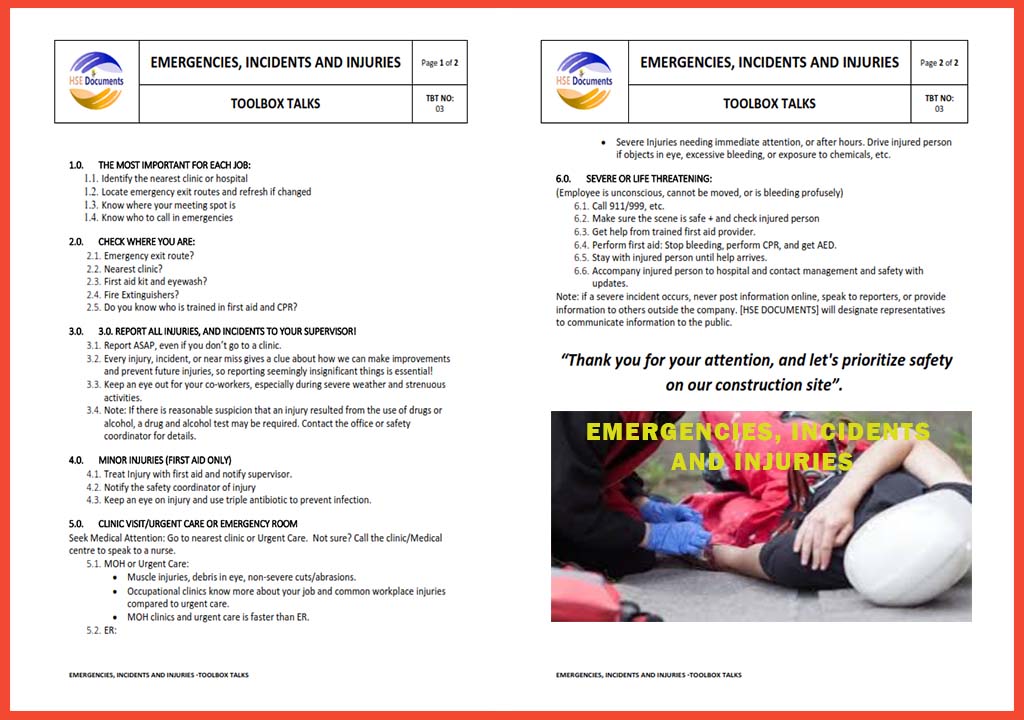 |
| HSE DOCUMENTS-EMERGENCIES, INCIDENTS AND INJURIES-TOOLBOX TALKS |
1.0. THE MOST IMPORTANT FOR EACH JOB:
1.1. Identify the nearest clinic or hospital
1.2. Locate emergency exit routes + refresh if changed
1.3. Know where your meeting spot is
1.4. Know who to call in emergencies
2.0. CHECK WHERE IS YOU’RE:
2.1. Emergency exit route?
2.2. Nearest clinic?
2.3. First aid kit and eyewash?
2.4. Fire Extinguishers?
2.5. Do you know who is trained in first aid and CPR?
3.0. REPORT ALL INJURIES, AND INCIDENTS TO YOUR SUPERVISOR!
3.1. Report ASAP, even if you don’t go to a clinic.
3.2. Every injury, incident, or near miss gives a clue about how we can make improvements and prevent future injuries, so reporting seemingly insignificant things is essential!
3.3. Keep an eye out for your co-workers, especially during severe weather and strenuous activities.
3.4. Note: If there is reasonable suspicion that an injury resulted from the use of drugs or alcohol, a drug and alcohol test may be required. Contact the office or safety coordinator for details.
4.0. MINOR INJURIES (FIRST AID ONLY)
4.1. Treat Injury with first aid and notify the supervisor.
4.2. Notify the safety coordinator of the injury
4.3. Keep an eye on injury and use triple antibiotics to prevent infection.
5.0. CLINIC VISIT/URGENT CARE OR EMERGENCY ROOM
Seek Medical Attention: Go to the nearest clinic or Urgent Care. Not sure? Call the clinic/Medical center to speak to a nurse.
5.1. MOH or Urgent Care:
Muscle injuries, debris in the eye, non-severe cuts/abrasions.
Occupational clinics know more about your job and common workplace injuries compared to urgent care.
MOH clinics and urgent care are faster than ERs.
5.2. ER:
Severe Injuries needing immediate attention, or after hours. Drive injured person if objects in the eye, excessive bleeding, exposure to chemicals, etc.
6.0. SEVERE OR LIFE-THREATENING:
(Employee is unconscious, cannot be moved, or is bleeding profusely)
6.1. Call 911/999, etc.
6.2. Make sure the scene is safe + and check an injured person
6.3. Get help from a trained first aid provider.
6.4. Perform first aid: Stop bleeding, perform CPR, and get AED.
6.5. Stay with the injured person until help arrives.
6.6. Accompany the injured person to the hospital and contact management and safety with updates.
Note: if a severe incident occurs, never post information online, speak to reporters, or provide information to others outside the company. [HSE DOCUMENTS] will designate representatives to communicate information to the public.






1.jpg)


No comments:
Post a Comment